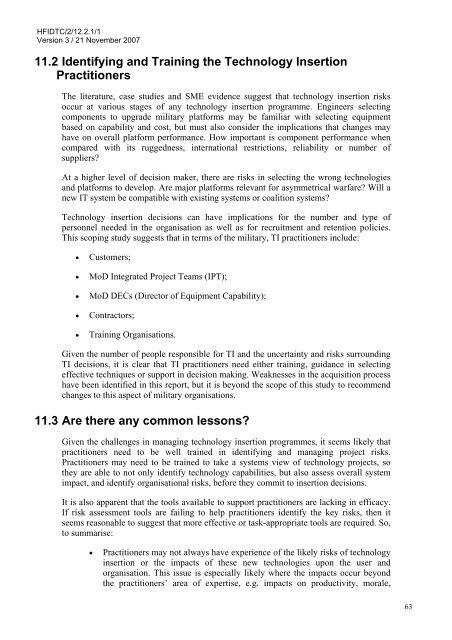The Impact of Technology Insertion on Organisations
The Impact of Technology Insertion on Organisations
The Impact of Technology Insertion on Organisations
Create successful ePaper yourself
Turn your PDF publications into a flip-book with our unique Google optimized e-Paper software.
HFIDTC/2/12.2.1/1<br />
Versi<strong>on</strong> 3 / 21 November 2007<br />
11.2 Identifying and Training the <str<strong>on</strong>g>Technology</str<strong>on</strong>g> <str<strong>on</strong>g>Inserti<strong>on</strong></str<strong>on</strong>g><br />
Practiti<strong>on</strong>ers<br />
<str<strong>on</strong>g>The</str<strong>on</strong>g> literature, case studies and SME evidence suggest that technology inserti<strong>on</strong> risks<br />
occur at various stages <str<strong>on</strong>g>of</str<strong>on</strong>g> any technology inserti<strong>on</strong> programme. Engineers selecting<br />
comp<strong>on</strong>ents to upgrade military platforms may be familiar with selecting equipment<br />
based <strong>on</strong> capability and cost, but must also c<strong>on</strong>sider the implicati<strong>on</strong>s that changes may<br />
have <strong>on</strong> overall platform performance. How important is comp<strong>on</strong>ent performance when<br />
compared with its ruggedness, internati<strong>on</strong>al restricti<strong>on</strong>s, reliability or number <str<strong>on</strong>g>of</str<strong>on</strong>g><br />
suppliers?<br />
At a higher level <str<strong>on</strong>g>of</str<strong>on</strong>g> decisi<strong>on</strong> maker, there are risks in selecting the wr<strong>on</strong>g technologies<br />
and platforms to develop. Are major platforms relevant for asymmetrical warfare? Will a<br />
new IT system be compatible with existing systems or coaliti<strong>on</strong> systems?<br />
<str<strong>on</strong>g>Technology</str<strong>on</strong>g> inserti<strong>on</strong> decisi<strong>on</strong>s can have implicati<strong>on</strong>s for the number and type <str<strong>on</strong>g>of</str<strong>on</strong>g><br />
pers<strong>on</strong>nel needed in the organisati<strong>on</strong> as well as for recruitment and retenti<strong>on</strong> policies.<br />
This scoping study suggests that in terms <str<strong>on</strong>g>of</str<strong>on</strong>g> the military, TI practiti<strong>on</strong>ers include:<br />
• Customers;<br />
• MoD Integrated Project Teams (IPT);<br />
• MoD DECs (Director <str<strong>on</strong>g>of</str<strong>on</strong>g> Equipment Capability);<br />
• C<strong>on</strong>tractors;<br />
• Training Organisati<strong>on</strong>s.<br />
Given the number <str<strong>on</strong>g>of</str<strong>on</strong>g> people resp<strong>on</strong>sible for TI and the uncertainty and risks surrounding<br />
TI decisi<strong>on</strong>s, it is clear that TI practiti<strong>on</strong>ers need either training, guidance in selecting<br />
effective techniques or support in decisi<strong>on</strong> making. Weaknesses in the acquisiti<strong>on</strong> process<br />
have been identified in this report, but it is bey<strong>on</strong>d the scope <str<strong>on</strong>g>of</str<strong>on</strong>g> this study to recommend<br />
changes to this aspect <str<strong>on</strong>g>of</str<strong>on</strong>g> military organisati<strong>on</strong>s.<br />
11.3 Are there any comm<strong>on</strong> less<strong>on</strong>s?<br />
Given the challenges in managing technology inserti<strong>on</strong> programmes, it seems likely that<br />
practiti<strong>on</strong>ers need to be well trained in identifying and managing project risks.<br />
Practiti<strong>on</strong>ers may need to be trained to take a systems view <str<strong>on</strong>g>of</str<strong>on</strong>g> technology projects, so<br />
they are able to not <strong>on</strong>ly identify technology capabilities, but also assess overall system<br />
impact, and identify organisati<strong>on</strong>al risks, before they commit to inserti<strong>on</strong> decisi<strong>on</strong>s.<br />
It is also apparent that the tools available to support practiti<strong>on</strong>ers are lacking in efficacy.<br />
If risk assessment tools are failing to help practiti<strong>on</strong>ers identify the key risks, then it<br />
seems reas<strong>on</strong>able to suggest that more effective or task-appropriate tools are required. So,<br />
to summarise:<br />
• Practiti<strong>on</strong>ers may not always have experience <str<strong>on</strong>g>of</str<strong>on</strong>g> the likely risks <str<strong>on</strong>g>of</str<strong>on</strong>g> technology<br />
inserti<strong>on</strong> or the impacts <str<strong>on</strong>g>of</str<strong>on</strong>g> these new technologies up<strong>on</strong> the user and<br />
organisati<strong>on</strong>. This issue is especially likely where the impacts occur bey<strong>on</strong>d<br />
the practiti<strong>on</strong>ers’ area <str<strong>on</strong>g>of</str<strong>on</strong>g> expertise, e.g. impacts <strong>on</strong> productivity, morale,<br />
63

















